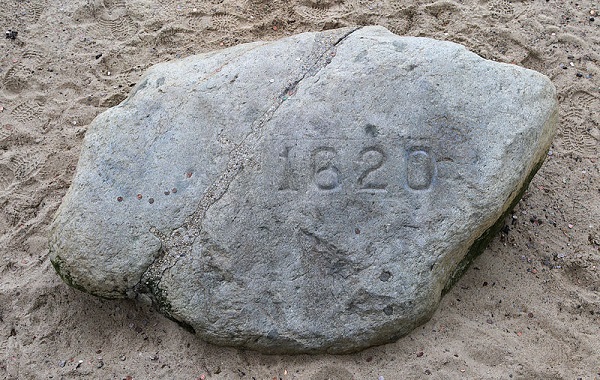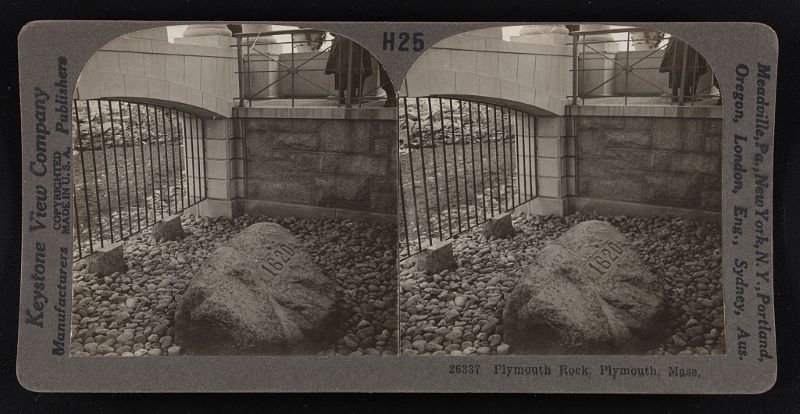Plymouth Rock is a historic granite boulder on Water Street in Plymouth, Mass that is believed to be the spot where the Mayflower pilgrims landed in 1620.
The rock is inscribed with the date 1620 to commemorate the pilgrim’s arrival. On July 1, 1970, Plymouth Rock was added to the National Register of Historic Places.
What is Plymouth Rock Made Out Of?
Plymouth Rock is comprised of Dedham granite that was formed 600 million years ago. The rock is a glacial erratic (non-native rock carried by a glacier over great distances) that was deposited on the beach in Plymouth by a glacier around 20,000 years ago.
How Big is Plymouth Rock?
Plymouth Rock currently weighs about 10 tons. The visible top third portion weighs about four tons and the buried bottom portion weighs about six tons.
Plymouth Rock is estimated to be only about one-third to one-half of its original size because it has been broken and chipped away at by 18th and 19th century souvenir hunters.
In 1620, it is estimated that Plymouth Rock weighed between 40 and 200 tons and measured about 15 feet long and 3 feet wide.
Two large fragments from the original rock are currently on display at the Smithsonian Institution’s Museum of American History, another fragment is on display at the Pilgrim Hall Museum in Plymouth and another large fragment is on display at Plymouth Church in Brooklyn, NY.
Is Plymouth Rock Cracked?
Plymouth rock has a crack down the middle because it broke in half when the colonists attempted to move it to Plymouth Square in 1774 to celebrate “Forefather’s Day.”
Half of the broken rock was moved to Plymouth Square for several decades while the other half remained on the beach where tourists and visitors chipped off pieces and fragments of it for souvenirs.
In 1880, the two halves were finally rejoined on the beach, cemented back together and inscribed with the date “1620.” In 1989, another crack in the rock was resealed during extensive restoration work.
Can You Touch Plymouth Rock?
No, visitors cannot touch Plymouth Rock because it is enclosed in a portico and is surrounded by a small iron fence to prevent people from accessing it.
The rock has been vandalized numerous time over the years. In 1938, the rock was splashed with red paint and in 1961 someone attempted to chip off a piece of the rock.
In 1970 and 1995, Native American activists buried the rock in sand as a part of their annual National Day of Mourning protests and in 1991 vandals painted a swastika on the rock.
Plymouth Rock was vandalized twice in 2020 when it was sprayed with red spray paint in February and then splashed with white paint in September.
Sources:
Vieira, Michael and J. North Conway. New England Rocks: Historic Geological Wonders. History Press, 2017.
Centennial History, General Society of Mayflower Descendants, 1897-1997. General Society of Mayflower Descendants, 1999.
“Pilgrim Memorial State Park.” Historical Marker Database, hmdb.org/m.asp?m=62450
“Swastika painted on Plymouth Rock.” UPI, 14 Aug. 1991, upi.com/Archives/1991/08/14/Swastika-painted-on-Plymouth-Rock/3240682142400/
“Plymouth Rock Vandalized For Second Time This Month.” CBS New Boston, 15 Sept. 2020, cbsnews.com/boston/news/plymouth-rock-vandalism-paste-paint-massachusetts/
Lee, Alicia. “Plymouth Rock, iconic landmark that marks where the Pilgrims first landed, was vandalized.” CNN, 17 Feb. 2020, cnn.com/travel/article/plymouth-rock-graffiti-vandalized-trnd/index.html
“Plymouth Rock fragment with painted inscription, 1830.” National Museum of American History, americanhistory.si.edu/collections/search/object/nmah_523279
“Beyond the Pilgrim Story.” Pilgrim Hall Museum, pilgrimhall.org/plymouth_rock.htm
Beem, Edgar Allen. “Plymouth Rock. Facts and Trivia.” New England, newengland.com/travel/massachusetts/plymouth-rock/
Lewis, Robert. “Plymouth Rock.” Britannica, britannica.com/topic/Plymouth-Rock-United-States-history
Gambino, Megan. “The True Story Behind Plymouth Rock.” Smithsonian Magazine, 20 Nov. 2017, smithsonianmag.com/smithsonian-institution/the-true-story-behind-plymouth-rock-639690/
“Plymouth Rock.” Frommer’s, frommers.com/destinations/plymouth-ma/attractions/plymouth-rock
“Plymouth Rock Piece.” Smithsonian, 22 Nov. 2011, si.edu/newsdesk/snapshot/plymouth-rock-piece
“Historic Other Detail: PLY.940 Plymouth Rock.” MACRIS, mhc-macris.net/details?mhcid=PLY.940


